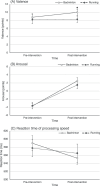Individual differences in affect in response to physical activity
- PMID: 40557364
- PMCID: PMC12186705
- DOI: 10.3389/fpsyg.2025.1575189
Individual differences in affect in response to physical activity
Abstract
Introduction: A single bout of physical activity can benefit one's psychological state, increasing positive affect. Individual differences in these feelings are known to correlate with mental health; however, individual differences in response to physical activity are unclear. This study aimed to quantitatively evaluate individual differences in affect in response to acute physical activities. Quantifying those individual differences implicitly assumed in previous studies would facilitate understanding the relationship between physical activity adherence and mental health.
Methods: The dataset comprised valence (pleasant-unpleasant) and arousal (active-inactive) measurements taken before and after two types of physical activities (running and badminton) with a crossover design. Valence and arousal were analyzed using a mixed model. Then, the intraclass correlation coefficients (ICCs) for valence and arousal, which are the ratio of the variance components of individual differences and the sum of total variance components, were calculated. Information processing in cognitive functions was also analyzed and compared variance components among valence, arousal, and information processing to comprehensively evaluate individual differences in valence and arousal in response to physical activity.
Results and discussion: The results showed that individual differences in valence and arousal in response to physical activity were significant variance components, whereas the variance component in information processing was not significant. The ICCs for valence, arousal, and information processing were 0.603 (95% confidence interval [95%CI]: 0.430-0.769), 0.349 (95%CI: 0.202-0.512), and 0.171 (95% CI: 0.164-0.217), respectively, demonstrating that the ICC for valence is significantly more pronounced than that for information processing. These findings indicate that the effects of physical activity on affect vary among individuals, particularly regarding changes in valence. Considering individual differences is essential when tailoring physical activity treatments for health.
Keywords: core affect; intraclass correlation coefficient; mixed model; variance component; vigorous physical activity.
Copyright © 2025 Takahashi, Sakairi and Grove.
Conflict of interest statement
The authors declare that the research was conducted in the absence of any commercial or financial relationships that could be construed as a potential conflict of interest.
Figures

Similar articles
-
Intravenous magnesium sulphate and sotalol for prevention of atrial fibrillation after coronary artery bypass surgery: a systematic review and economic evaluation.Health Technol Assess. 2008 Jun;12(28):iii-iv, ix-95. doi: 10.3310/hta12280. Health Technol Assess. 2008. PMID: 18547499
-
Behavioral interventions to reduce risk for sexual transmission of HIV among men who have sex with men.Cochrane Database Syst Rev. 2008 Jul 16;(3):CD001230. doi: 10.1002/14651858.CD001230.pub2. Cochrane Database Syst Rev. 2008. PMID: 18646068
-
Sertindole for schizophrenia.Cochrane Database Syst Rev. 2005 Jul 20;2005(3):CD001715. doi: 10.1002/14651858.CD001715.pub2. Cochrane Database Syst Rev. 2005. PMID: 16034864 Free PMC article.
-
Immunogenicity and seroefficacy of pneumococcal conjugate vaccines: a systematic review and network meta-analysis.Health Technol Assess. 2024 Jul;28(34):1-109. doi: 10.3310/YWHA3079. Health Technol Assess. 2024. PMID: 39046101 Free PMC article.
-
Systemic pharmacological treatments for chronic plaque psoriasis: a network meta-analysis.Cochrane Database Syst Rev. 2017 Dec 22;12(12):CD011535. doi: 10.1002/14651858.CD011535.pub2. Cochrane Database Syst Rev. 2017. Update in: Cochrane Database Syst Rev. 2020 Jan 9;1:CD011535. doi: 10.1002/14651858.CD011535.pub3. PMID: 29271481 Free PMC article. Updated.
References
-
- ACSM (2021). ACSM'S guidelines for exercise testing and prescription. 11th Edn. Philadelphia, PA: Lippincott Williams & Wilkins.
-
- Behrendt T., Kirschnick F., Kröger L., Beileke P., Rezepin M., Brigadski T., et al. (2021). Comparison of the effects of open vs. closed skill exercise on the acute and chronic BDNF, IGF-1 and IL-6 response in older healthy adults. BMC Neurosci. 22, 1–19. doi: 10.1186/s12868-021-00675-8 - DOI - PMC - PubMed
-
- Biddle S. J., Ciaccioni S., Thomas G., Vergeer I. (2019). Physical activity and mental health in children and adolescents: an updated review of reviews and an analysis of causality. Psychol. Sport Exerc. 42, 146–155. doi: 10.1016/j.psychsport.2018.08.011 - DOI
-
- Bourke M., Hilland T. A., Craike M. (2022). Daily physical activity and satisfaction with life in adolescents: an ecological momentary assessment study exploring direct associations and the mediating role of core affect. J. Happiness Stud. 23, 949–968. doi: 10.1007/s10902-021-00431-z - DOI
LinkOut - more resources
Full Text Sources

